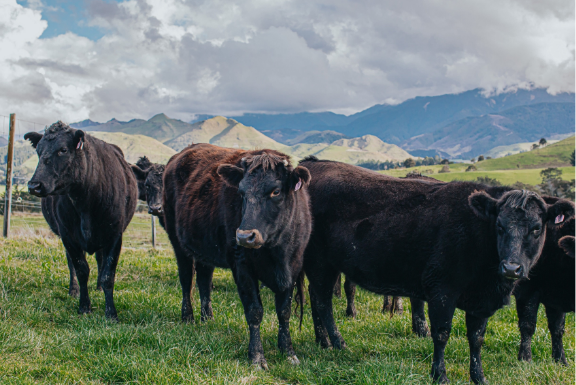First, let’s define what we mean by regenerative. Regenerative practices, especially in agriculture and apparel, go beyond sustainability by not just minimizing harm but actively revitalizing and enhancing the involved systems. Unlike sustainability, which focuses on preserving existing conditions, regenerative methods proactively improve and restore them, providing both environmental and societal benefits. Key thought leaders include Savory Institute, Rodale Institute, and Regenerative Rising.
As a real and practical example: Clade’s leather partner, First Light Farms in New Zealand, manages one of the world’s preeminent regenerative Wagyu herds. The effect of their livestock moving around the pastures all day long in natural, wild patterns and behaviors enhances soil health, increases biodiversity, and rejuvenates the land. First Light Farms’ holistic approach improves the resources in play, and, going well beyond preservation, regenerates the biome itself.

Now let’s talk about why any of this matters. The apparel industry is widely acknowledged as the second-most pollutive globally, after the oil industry. By some accounts it produces fully 10% of global industrial carbon emissions, if CO2 is your key concern.
Fast fashion encourages general corner-cutting, terrible environmental disregard, and a sort of throwaway mentality toward clothing that addicts people to ceaseless novelty and teaches them to be wasteful and pollutive themselves. This is to say nothing of the rife human exploitation involved with making shoddy, disposable clothing. And being honest, we’ve all taken part in it.
And all this environmental and moral damage is done by choice, not of necessity. That’s the astounding part. It isn’t as though we didn’t have much of a choice. We totally have.
So, we can still change everything about the apparel industry. But it’s important for our partners to understand that at Clade, we didn’t set out to make eco-friendly clothing merely at a par with what’s out there now.
Our thesis is that what is regenerative, natural and most sound – be it bovine leather, merino, or any other fiber – will give rise to the best product. The idea that nature – not humankind – has the answers to our most pressing problems. Anyone can make a sub-standard but eco-friendly garment – that’s quite easy. We set out to make the best garment period, much like Tesla set out to make the best car which happened also to be an EV. And did so.
We’ve seen other huge industries like food and personal care go exactly this way and the result is always the same – what is natural and organic winds up being best in performance terms, just as what is natural and organic is what is good, in ecological terms.
We believe apparel and other durables will evolve in the same way: the convergence of natural and best. It’s sort of like wellness megatrend, which is the convergence of what is pleasant with what is actually good for you. It cuts across industries, you can’t stop it, and if you invest early you might just achieve the ideal reality: doing good and doing well, too.
At Clade we view the potential of regenerative apparel as quite vast. Provided we make clothing that performs superbly well in terms of beauty, usefulness, and durability, our regenerative and eco-friendly approach can provide another layer of meaning for people to interact with. And meaning really is all that’s left for brands to uniquely own and offer to people be they vendors, customers, partners or investors.
And we’re standing on the shoulders of giants, here, which is always exhilarating and scary in a good way. Two case study brands come easily to mind, both born 50 years ago this year in 1973: Roots Canada and Patagonia.
I grew up in Toronto and watched Roots achieve more by doing less, by making things from the best, natural materials, fabricated locally, designed to be timelessly beautiful and right, and made to last basically forever. I collect Roots leather jackets to this day, they’re that good.
Patagonia made clothing in which to enjoy the outdoors and in such a way as to preserve the outdoors – a brilliant circularity, that – and they made them well. I wear a pair of river shorts from Patagonia that I bought in 1994 and they still perform and draw praise to this day.
It is too early to say whether everything we do at Clade will be as regenerative as our Wagyu leather jackets. It probably will. We have very high confidence in regenerative merino wool as a solution to a lot of big apparel demands, and we’ve spent the last several years understanding that value chain and getting it set up. Like leather, merino is basically nature’s miracle fibre, and we used to make everything out of it, not just sweaters and Brioni suits.
In contrast, cotton, even when it’s organic, is very, very hard on the land. So is traditionally-dyed indigo denim very pollutive just by its very nature. We certainly can’t make clothing from plastics – even recycled plastics – because the plastics wind up getting washed into the rivers and oceans no matter what you do.
Our approach so far: we have fully transparent supply chains and ethical sourcing from farm to wardrobe. We are innovating in fabrics and design to achieve regenerative practices across many garment classifications. We are devoted to social impact through ethical labor practices – we make our goods in NYC in factories where people are secure and healthy. And we design and create gear for a small audience to whom we think this all caters well.
More to come!
Read more
We spent time with Phil Winters at his brewery in Caledon, Ontario, Goodlot Farmstead Brewery, a remarkable place.
We see the ultimate goals of our company, Clade, as: living our values in such a way as to do what is virtuous, helping ourselves and others reach their full potential, and being rational – or if y...


